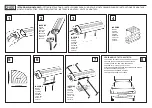
YH4
GRAND
VITARA
2
3
1. Malfunction indicator lamp (MIL)
2. Data link connector (DLC)
3. SUZUKI scan tool (TECH 1)
or
6-6
ENGINE DIAGNOSIS (G16 / J20 ENGINES)
ENGINE DIAGNOSIS
GENERAL DESCRIPTION
This vehicle is equipped with an engine and emission control system which are under control of ECM (PCM).
The engine and emission control system in this vehicle are controlled by ECM (PCM). ECM (PCM) has an On-
Board Diagnostic system which detects a malfunction in this system and abnormality of those parts that influence
the engine exhaust emission. When diagnosing engine troubles, be sure to have full understanding of the outline
of “On-Board Diagnostic System” and each item in “Precaution in Diagnosing Trouble” and execute diagnosis ac-
cording to “ENGINE DIAGNOSTIC FLOW TABLE”.
There is a close relationship between the engine mechanical, engine cooling system, ignition system, exhaust
system, etc. and the engine and emission control system in their structure and operation. In case of an engine
trouble, even when the malfunction indicator lamp (MIL, “SERVICE ENGINE SOON” lamp) doesn’t turn ON, it
should be diagnosed according to this flow table.
ON-BOARD DIAGNOSTIC SYSTEM
(VEHICLE WITHOUT MONITOR CONNECTOR)
ECM (PCM) in this vehicle has the following functions.
When the ignition switch is turned ON with the engine at a stop,
MIL turns ON to check the bulb of the malfunction indicator lamp
(MIL).
When ECM (PCM) detects a malfunction which gives an adverse
effect to vehicle emission while the engine is running, it makes the
malfunction indicator lamp in the meter cluster of the instrument
panel turn ON or flash (flashing only when detecting a misfire
which can cause damage to the catalyst) and stores the malfunc-
tion area in its memory.
(If it detects that continuously 3 driving cycles are normal after de-
tecting a malfunction, however, it makes MIL turn OFF although
DTC stored in its memory will remain.)
As a condition for detecting a malfunction in some areas in the
system being monitored by ECM (PCM) and turning ON the mal-
function indicator lamp due to that malfunction, 2 driving cycles
detection logic is adopted to prevent erroneous detection.
When a malfunction is detected, engine and driving conditions
then are stored in ECM (PCM) memory as freeze frame data. (For
the details, refer to description on Freeze frame data.)
It is possible to communicate by using not only SUZUKI scan tool
(Tech-1) but also generic scan tool. (Diagnostic information can
be accessed by using a scan tool.)
Summary of Contents for 2000 Grand Vitara SQ416
Page 75: ...ENGINE DIAGNOSIS G16 J20 ENGINES 6 71 Fig 1 for Step 3...
Page 179: ...6 1 68 ENGINE H25 ENGINE a Fig for STEP 2 3 a HO2S heater relay...
Page 190: ...ENGINE H25 ENGINE 6 1 79 a Fig for STEP 2 3 a HO2S heater relay...
Page 541: ...6E1 4 ENGINE AND EMISSION CONTROL SYSTEM G16 J20 ENGINES G16 ENGINE...
Page 542: ...ENGINE AND EMISSION CONTROL SYSTEM G16 J20 ENGINES 6E1 5...
Page 543: ...6E1 6 ENGINE AND EMISSION CONTROL SYSTEM G16 J20 ENGINES J20 ENGINE...
Page 544: ...ENGINE AND EMISSION CONTROL SYSTEM G16 J20 ENGINES 6E1 7...
Page 552: ...ENGINE AND EMISSION CONTROL SYSTEM G16 J20 ENGINES 6E1 15...
Page 592: ...6E2 4 ENGINE AND EMISSION CONTROL SYSTEM H25 ENGINE...
Page 593: ...ENGINE AND EMISSION CONTROL SYSTEM H25 ENGINE 6E2 5...
Page 597: ...ENGINE AND EMISSION CONTROL SYSTEM H25 ENGINE 6E2 9...
Page 723: ...6H 30 CHARGING SYSTEM 17 Make sure that rotor turns smoothly...










































